Nursing Leadership: Professional Goals, SWOT Analysis, and Steps
VerifiedAdded on 2022/12/18
|7
|1419
|1
Report
AI Summary
This report, focused on nursing leadership, outlines the student's goals for transitioning to professional practice. It includes a detailed SWOT analysis, identifying strengths, weaknesses, opportunities, and threats relevant to their career aspirations. The report then defines professional goals, both educational (completing a BSN) and clinical (becoming a psych nurse practitioner and working with organizations like the Red Cross and Doctors Without Borders). It further details the steps required to achieve these goals, the resources needed (including funding and support), and a timeframe for accomplishment. The report references Miller's Wheel of Professionalism to highlight the importance of professional development and community involvement. The student plans to leverage their existing experience as a telemetry nurse and LPN to achieve their future career goals in the field of nursing.
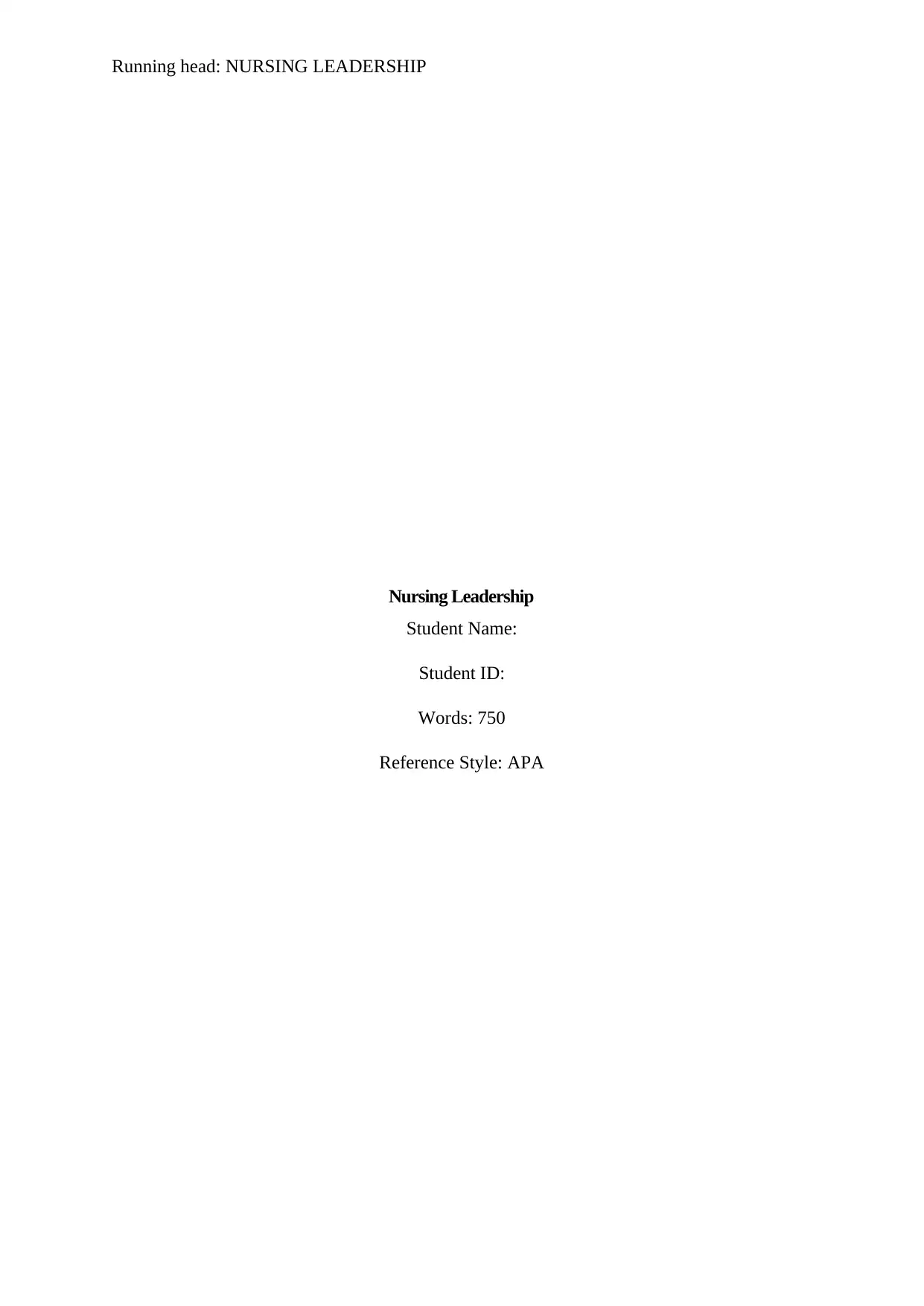
Running head: NURSING LEADERSHIP
Nursing Leadership
Student Name:
Student ID:
Words: 750
Reference Style: APA
Nursing Leadership
Student Name:
Student ID:
Words: 750
Reference Style: APA
Paraphrase This Document
Need a fresh take? Get an instant paraphrase of this document with our AI Paraphraser
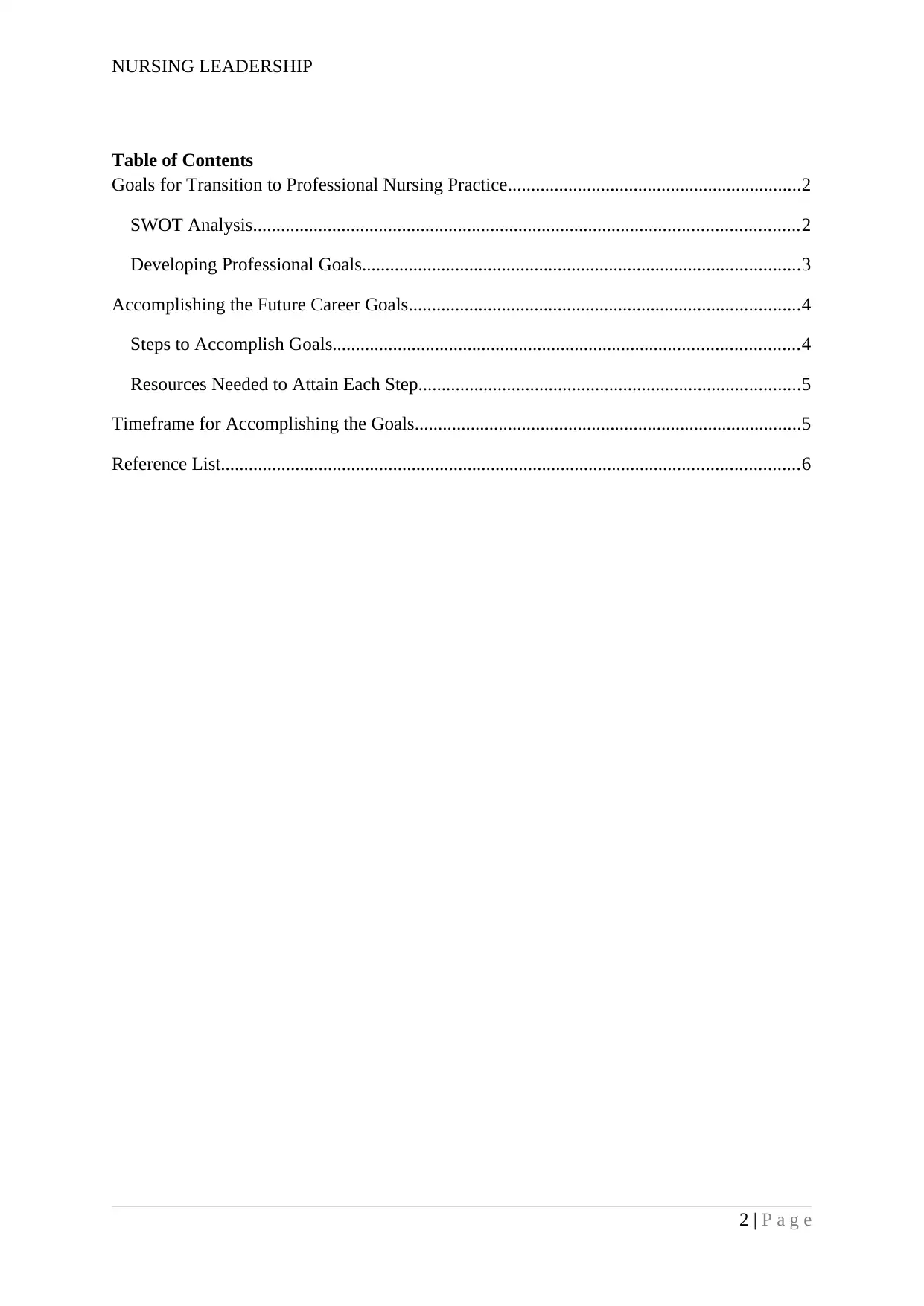
NURSING LEADERSHIP
Table of Contents
Goals for Transition to Professional Nursing Practice...............................................................2
SWOT Analysis.....................................................................................................................2
Developing Professional Goals..............................................................................................3
Accomplishing the Future Career Goals....................................................................................4
Steps to Accomplish Goals....................................................................................................4
Resources Needed to Attain Each Step..................................................................................5
Timeframe for Accomplishing the Goals...................................................................................5
Reference List............................................................................................................................6
2 | P a g e
Table of Contents
Goals for Transition to Professional Nursing Practice...............................................................2
SWOT Analysis.....................................................................................................................2
Developing Professional Goals..............................................................................................3
Accomplishing the Future Career Goals....................................................................................4
Steps to Accomplish Goals....................................................................................................4
Resources Needed to Attain Each Step..................................................................................5
Timeframe for Accomplishing the Goals...................................................................................5
Reference List............................................................................................................................6
2 | P a g e
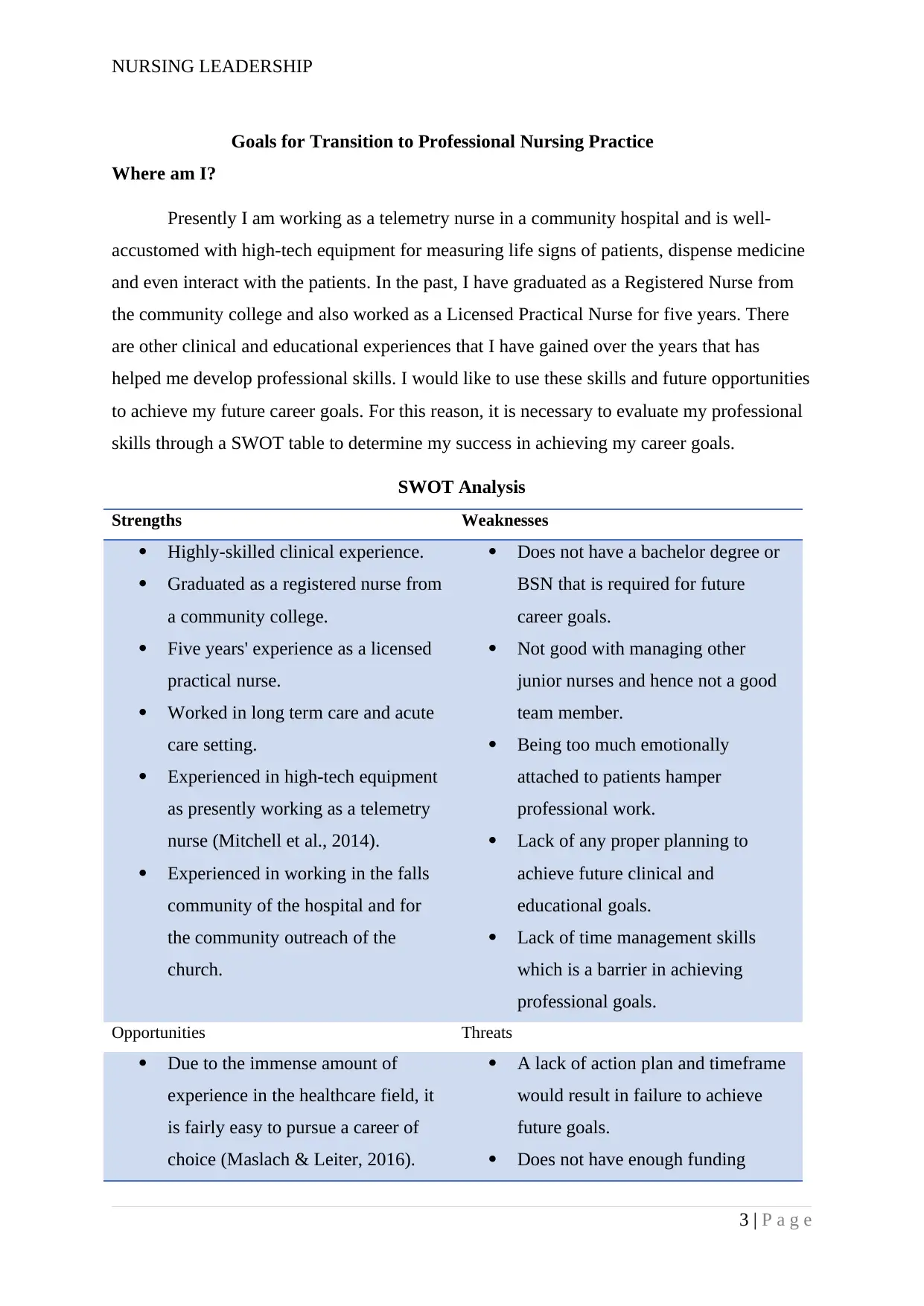
NURSING LEADERSHIP
Goals for Transition to Professional Nursing Practice
Where am I?
Presently I am working as a telemetry nurse in a community hospital and is well-
accustomed with high-tech equipment for measuring life signs of patients, dispense medicine
and even interact with the patients. In the past, I have graduated as a Registered Nurse from
the community college and also worked as a Licensed Practical Nurse for five years. There
are other clinical and educational experiences that I have gained over the years that has
helped me develop professional skills. I would like to use these skills and future opportunities
to achieve my future career goals. For this reason, it is necessary to evaluate my professional
skills through a SWOT table to determine my success in achieving my career goals.
SWOT Analysis
Strengths Weaknesses
Highly-skilled clinical experience.
Graduated as a registered nurse from
a community college.
Five years' experience as a licensed
practical nurse.
Worked in long term care and acute
care setting.
Experienced in high-tech equipment
as presently working as a telemetry
nurse (Mitchell et al., 2014).
Experienced in working in the falls
community of the hospital and for
the community outreach of the
church.
Does not have a bachelor degree or
BSN that is required for future
career goals.
Not good with managing other
junior nurses and hence not a good
team member.
Being too much emotionally
attached to patients hamper
professional work.
Lack of any proper planning to
achieve future clinical and
educational goals.
Lack of time management skills
which is a barrier in achieving
professional goals.
Opportunities Threats
Due to the immense amount of
experience in the healthcare field, it
is fairly easy to pursue a career of
choice (Maslach & Leiter, 2016).
A lack of action plan and timeframe
would result in failure to achieve
future goals.
Does not have enough funding
3 | P a g e
Goals for Transition to Professional Nursing Practice
Where am I?
Presently I am working as a telemetry nurse in a community hospital and is well-
accustomed with high-tech equipment for measuring life signs of patients, dispense medicine
and even interact with the patients. In the past, I have graduated as a Registered Nurse from
the community college and also worked as a Licensed Practical Nurse for five years. There
are other clinical and educational experiences that I have gained over the years that has
helped me develop professional skills. I would like to use these skills and future opportunities
to achieve my future career goals. For this reason, it is necessary to evaluate my professional
skills through a SWOT table to determine my success in achieving my career goals.
SWOT Analysis
Strengths Weaknesses
Highly-skilled clinical experience.
Graduated as a registered nurse from
a community college.
Five years' experience as a licensed
practical nurse.
Worked in long term care and acute
care setting.
Experienced in high-tech equipment
as presently working as a telemetry
nurse (Mitchell et al., 2014).
Experienced in working in the falls
community of the hospital and for
the community outreach of the
church.
Does not have a bachelor degree or
BSN that is required for future
career goals.
Not good with managing other
junior nurses and hence not a good
team member.
Being too much emotionally
attached to patients hamper
professional work.
Lack of any proper planning to
achieve future clinical and
educational goals.
Lack of time management skills
which is a barrier in achieving
professional goals.
Opportunities Threats
Due to the immense amount of
experience in the healthcare field, it
is fairly easy to pursue a career of
choice (Maslach & Leiter, 2016).
A lack of action plan and timeframe
would result in failure to achieve
future goals.
Does not have enough funding
3 | P a g e
⊘ This is a preview!⊘
Do you want full access?
Subscribe today to unlock all pages.

Trusted by 1+ million students worldwide
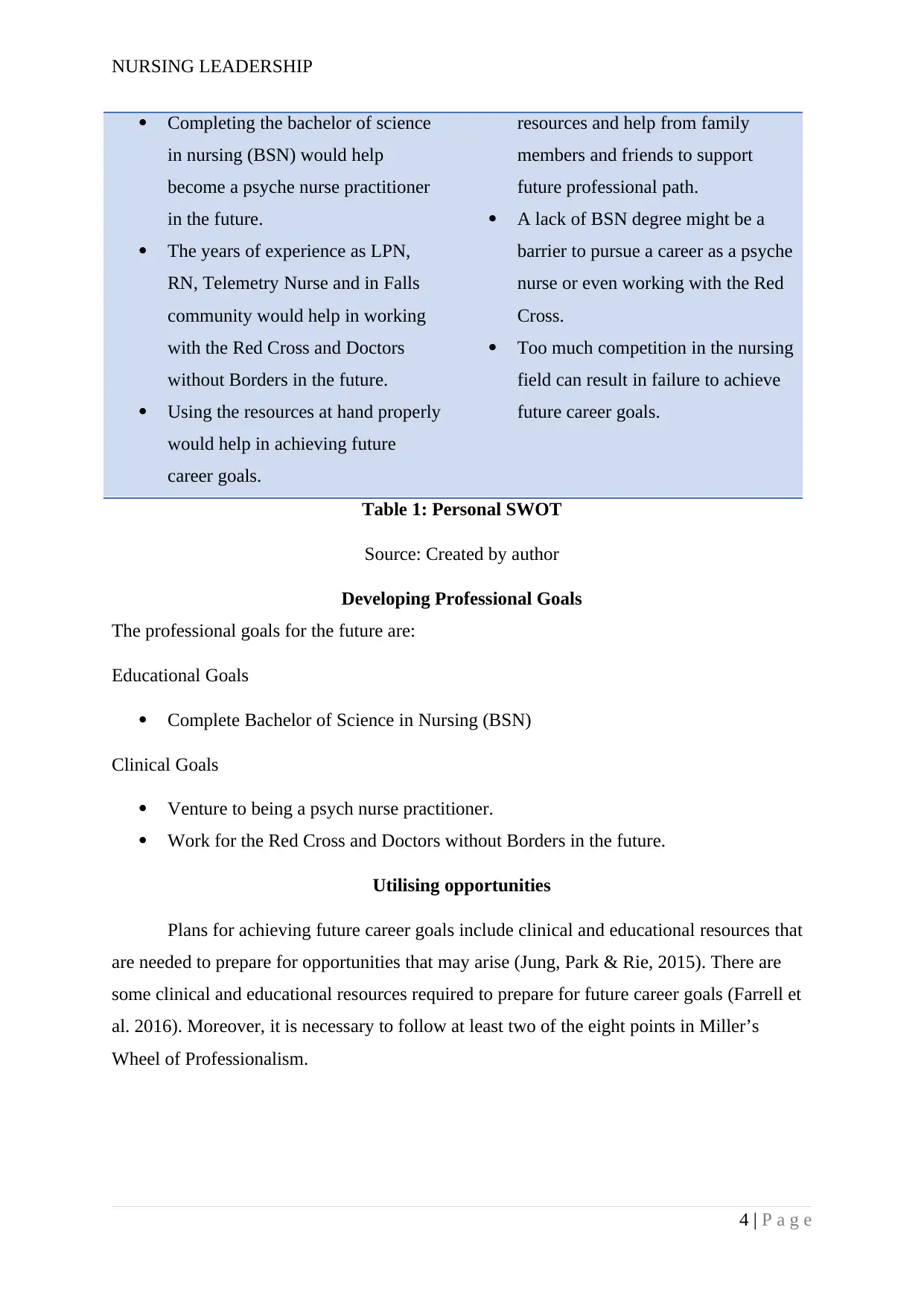
NURSING LEADERSHIP
Completing the bachelor of science
in nursing (BSN) would help
become a psyche nurse practitioner
in the future.
The years of experience as LPN,
RN, Telemetry Nurse and in Falls
community would help in working
with the Red Cross and Doctors
without Borders in the future.
Using the resources at hand properly
would help in achieving future
career goals.
resources and help from family
members and friends to support
future professional path.
A lack of BSN degree might be a
barrier to pursue a career as a psyche
nurse or even working with the Red
Cross.
Too much competition in the nursing
field can result in failure to achieve
future career goals.
Table 1: Personal SWOT
Source: Created by author
Developing Professional Goals
The professional goals for the future are:
Educational Goals
Complete Bachelor of Science in Nursing (BSN)
Clinical Goals
Venture to being a psych nurse practitioner.
Work for the Red Cross and Doctors without Borders in the future.
Utilising opportunities
Plans for achieving future career goals include clinical and educational resources that
are needed to prepare for opportunities that may arise (Jung, Park & Rie, 2015). There are
some clinical and educational resources required to prepare for future career goals (Farrell et
al. 2016). Moreover, it is necessary to follow at least two of the eight points in Miller’s
Wheel of Professionalism.
4 | P a g e
Completing the bachelor of science
in nursing (BSN) would help
become a psyche nurse practitioner
in the future.
The years of experience as LPN,
RN, Telemetry Nurse and in Falls
community would help in working
with the Red Cross and Doctors
without Borders in the future.
Using the resources at hand properly
would help in achieving future
career goals.
resources and help from family
members and friends to support
future professional path.
A lack of BSN degree might be a
barrier to pursue a career as a psyche
nurse or even working with the Red
Cross.
Too much competition in the nursing
field can result in failure to achieve
future career goals.
Table 1: Personal SWOT
Source: Created by author
Developing Professional Goals
The professional goals for the future are:
Educational Goals
Complete Bachelor of Science in Nursing (BSN)
Clinical Goals
Venture to being a psych nurse practitioner.
Work for the Red Cross and Doctors without Borders in the future.
Utilising opportunities
Plans for achieving future career goals include clinical and educational resources that
are needed to prepare for opportunities that may arise (Jung, Park & Rie, 2015). There are
some clinical and educational resources required to prepare for future career goals (Farrell et
al. 2016). Moreover, it is necessary to follow at least two of the eight points in Miller’s
Wheel of Professionalism.
4 | P a g e
Paraphrase This Document
Need a fresh take? Get an instant paraphrase of this document with our AI Paraphraser
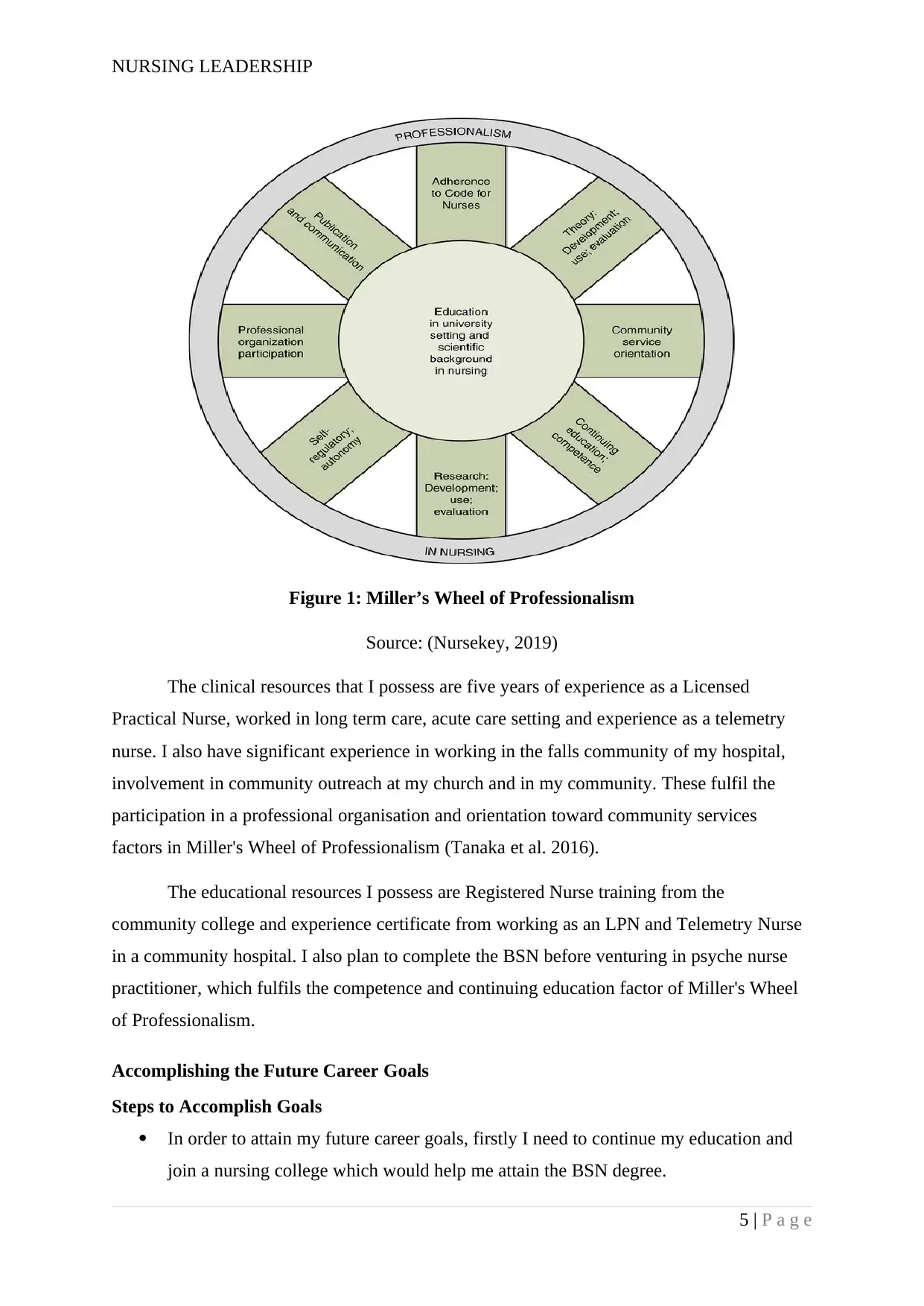
NURSING LEADERSHIP
Figure 1: Miller’s Wheel of Professionalism
Source: (Nursekey, 2019)
The clinical resources that I possess are five years of experience as a Licensed
Practical Nurse, worked in long term care, acute care setting and experience as a telemetry
nurse. I also have significant experience in working in the falls community of my hospital,
involvement in community outreach at my church and in my community. These fulfil the
participation in a professional organisation and orientation toward community services
factors in Miller's Wheel of Professionalism (Tanaka et al. 2016).
The educational resources I possess are Registered Nurse training from the
community college and experience certificate from working as an LPN and Telemetry Nurse
in a community hospital. I also plan to complete the BSN before venturing in psyche nurse
practitioner, which fulfils the competence and continuing education factor of Miller's Wheel
of Professionalism.
Accomplishing the Future Career Goals
Steps to Accomplish Goals
In order to attain my future career goals, firstly I need to continue my education and
join a nursing college which would help me attain the BSN degree.
5 | P a g e
Figure 1: Miller’s Wheel of Professionalism
Source: (Nursekey, 2019)
The clinical resources that I possess are five years of experience as a Licensed
Practical Nurse, worked in long term care, acute care setting and experience as a telemetry
nurse. I also have significant experience in working in the falls community of my hospital,
involvement in community outreach at my church and in my community. These fulfil the
participation in a professional organisation and orientation toward community services
factors in Miller's Wheel of Professionalism (Tanaka et al. 2016).
The educational resources I possess are Registered Nurse training from the
community college and experience certificate from working as an LPN and Telemetry Nurse
in a community hospital. I also plan to complete the BSN before venturing in psyche nurse
practitioner, which fulfils the competence and continuing education factor of Miller's Wheel
of Professionalism.
Accomplishing the Future Career Goals
Steps to Accomplish Goals
In order to attain my future career goals, firstly I need to continue my education and
join a nursing college which would help me attain the BSN degree.
5 | P a g e
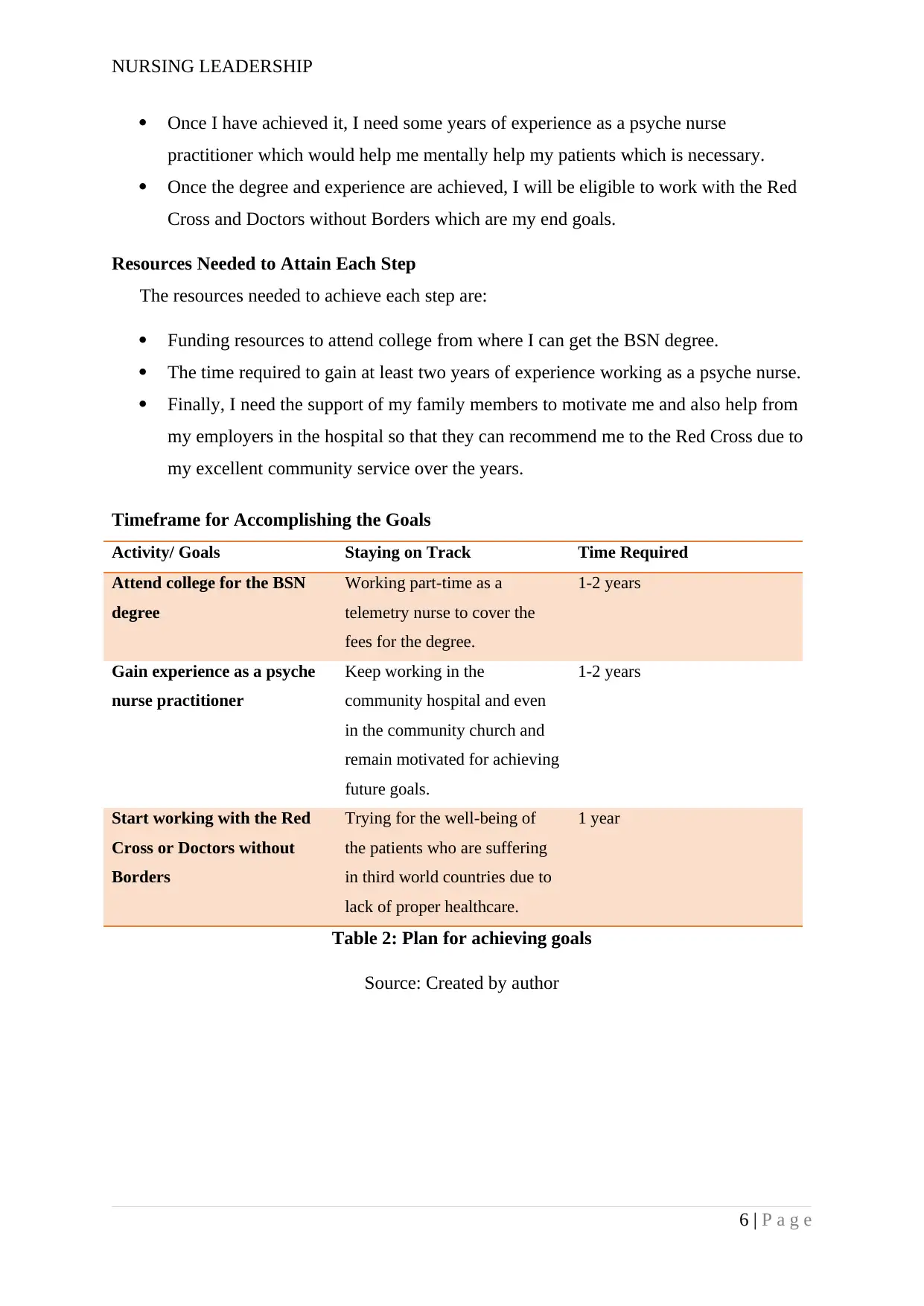
NURSING LEADERSHIP
Once I have achieved it, I need some years of experience as a psyche nurse
practitioner which would help me mentally help my patients which is necessary.
Once the degree and experience are achieved, I will be eligible to work with the Red
Cross and Doctors without Borders which are my end goals.
Resources Needed to Attain Each Step
The resources needed to achieve each step are:
Funding resources to attend college from where I can get the BSN degree.
The time required to gain at least two years of experience working as a psyche nurse.
Finally, I need the support of my family members to motivate me and also help from
my employers in the hospital so that they can recommend me to the Red Cross due to
my excellent community service over the years.
Timeframe for Accomplishing the Goals
Activity/ Goals Staying on Track Time Required
Attend college for the BSN
degree
Working part-time as a
telemetry nurse to cover the
fees for the degree.
1-2 years
Gain experience as a psyche
nurse practitioner
Keep working in the
community hospital and even
in the community church and
remain motivated for achieving
future goals.
1-2 years
Start working with the Red
Cross or Doctors without
Borders
Trying for the well-being of
the patients who are suffering
in third world countries due to
lack of proper healthcare.
1 year
Table 2: Plan for achieving goals
Source: Created by author
6 | P a g e
Once I have achieved it, I need some years of experience as a psyche nurse
practitioner which would help me mentally help my patients which is necessary.
Once the degree and experience are achieved, I will be eligible to work with the Red
Cross and Doctors without Borders which are my end goals.
Resources Needed to Attain Each Step
The resources needed to achieve each step are:
Funding resources to attend college from where I can get the BSN degree.
The time required to gain at least two years of experience working as a psyche nurse.
Finally, I need the support of my family members to motivate me and also help from
my employers in the hospital so that they can recommend me to the Red Cross due to
my excellent community service over the years.
Timeframe for Accomplishing the Goals
Activity/ Goals Staying on Track Time Required
Attend college for the BSN
degree
Working part-time as a
telemetry nurse to cover the
fees for the degree.
1-2 years
Gain experience as a psyche
nurse practitioner
Keep working in the
community hospital and even
in the community church and
remain motivated for achieving
future goals.
1-2 years
Start working with the Red
Cross or Doctors without
Borders
Trying for the well-being of
the patients who are suffering
in third world countries due to
lack of proper healthcare.
1 year
Table 2: Plan for achieving goals
Source: Created by author
6 | P a g e
⊘ This is a preview!⊘
Do you want full access?
Subscribe today to unlock all pages.

Trusted by 1+ million students worldwide
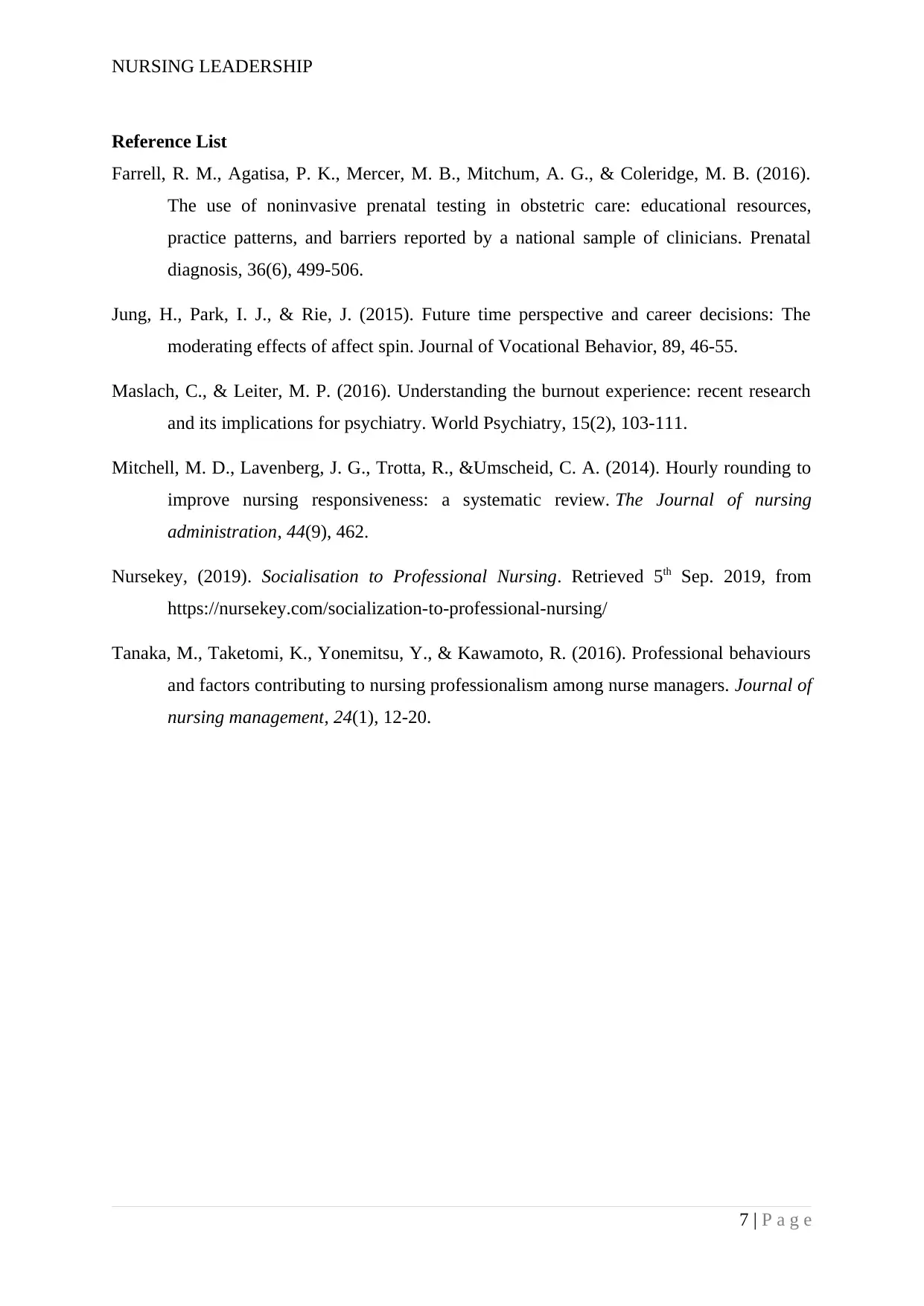
NURSING LEADERSHIP
Reference List
Farrell, R. M., Agatisa, P. K., Mercer, M. B., Mitchum, A. G., & Coleridge, M. B. (2016).
The use of noninvasive prenatal testing in obstetric care: educational resources,
practice patterns, and barriers reported by a national sample of clinicians. Prenatal
diagnosis, 36(6), 499-506.
Jung, H., Park, I. J., & Rie, J. (2015). Future time perspective and career decisions: The
moderating effects of affect spin. Journal of Vocational Behavior, 89, 46-55.
Maslach, C., & Leiter, M. P. (2016). Understanding the burnout experience: recent research
and its implications for psychiatry. World Psychiatry, 15(2), 103-111.
Mitchell, M. D., Lavenberg, J. G., Trotta, R., &Umscheid, C. A. (2014). Hourly rounding to
improve nursing responsiveness: a systematic review. The Journal of nursing
administration, 44(9), 462.
Nursekey, (2019). Socialisation to Professional Nursing. Retrieved 5th Sep. 2019, from
https://nursekey.com/socialization-to-professional-nursing/
Tanaka, M., Taketomi, K., Yonemitsu, Y., & Kawamoto, R. (2016). Professional behaviours
and factors contributing to nursing professionalism among nurse managers. Journal of
nursing management, 24(1), 12-20.
7 | P a g e
Reference List
Farrell, R. M., Agatisa, P. K., Mercer, M. B., Mitchum, A. G., & Coleridge, M. B. (2016).
The use of noninvasive prenatal testing in obstetric care: educational resources,
practice patterns, and barriers reported by a national sample of clinicians. Prenatal
diagnosis, 36(6), 499-506.
Jung, H., Park, I. J., & Rie, J. (2015). Future time perspective and career decisions: The
moderating effects of affect spin. Journal of Vocational Behavior, 89, 46-55.
Maslach, C., & Leiter, M. P. (2016). Understanding the burnout experience: recent research
and its implications for psychiatry. World Psychiatry, 15(2), 103-111.
Mitchell, M. D., Lavenberg, J. G., Trotta, R., &Umscheid, C. A. (2014). Hourly rounding to
improve nursing responsiveness: a systematic review. The Journal of nursing
administration, 44(9), 462.
Nursekey, (2019). Socialisation to Professional Nursing. Retrieved 5th Sep. 2019, from
https://nursekey.com/socialization-to-professional-nursing/
Tanaka, M., Taketomi, K., Yonemitsu, Y., & Kawamoto, R. (2016). Professional behaviours
and factors contributing to nursing professionalism among nurse managers. Journal of
nursing management, 24(1), 12-20.
7 | P a g e
1 out of 7
Related Documents
Your All-in-One AI-Powered Toolkit for Academic Success.
+13062052269
info@desklib.com
Available 24*7 on WhatsApp / Email
![[object Object]](/_next/static/media/star-bottom.7253800d.svg)
Unlock your academic potential
Copyright © 2020–2025 A2Z Services. All Rights Reserved. Developed and managed by ZUCOL.




